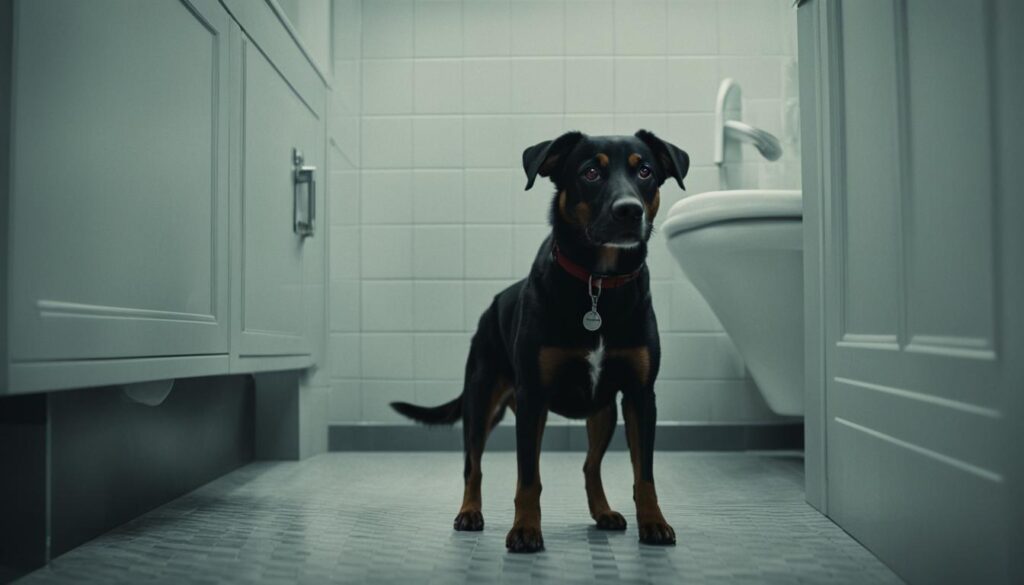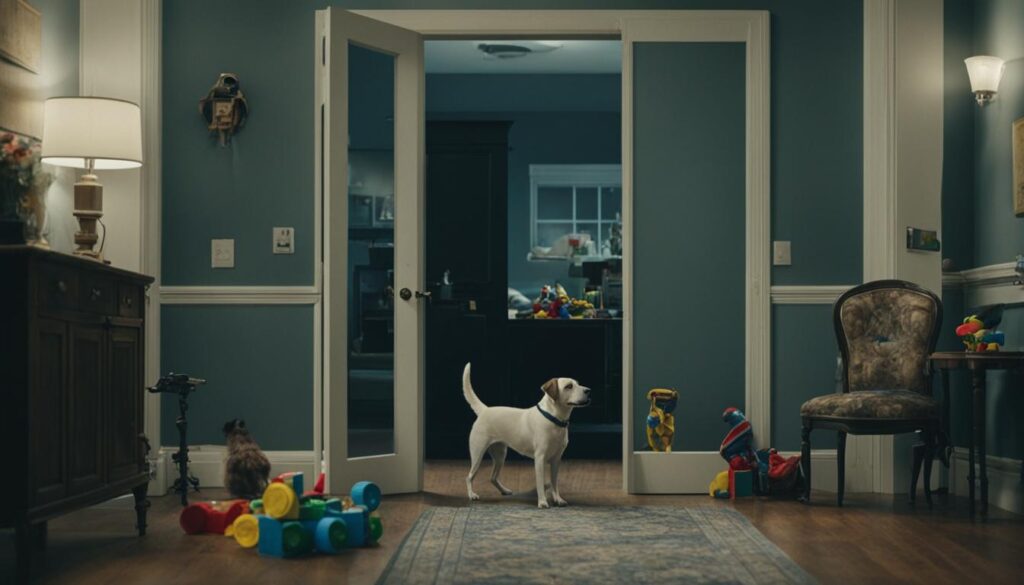Loyalty is a valued trait in dogs, but sometimes our furry companions can exhibit excessively clingy behavior, leaving us puzzled and wondering why. If you find yourself asking, “Why is my dog so clingy?” you’re not alone. Clingy dog behavior, also known as velcro dog syndrome, is characterized by dogs constantly following their owners, refusing to be left alone, and becoming anxious when separated.
There are several reasons why a dog may display clingy behavior. It can be attributed to stress and anxiety, health issues, learned behavior, inadequate socialization, curiosity or FOMO (fear of missing out), boredom, or even mating season. Understanding the underlying reasons behind your dog’s clinginess is crucial in effectively addressing and managing this behavior.
In this article, I will delve deeper into the reasons behind clingy behavior in dogs and provide you with practical tips for dealing with a clingy dog. Whether you’re experiencing dog separation anxiety, attachment issues, or general behavior problems, this article will help you gain a better understanding of clinginess in dogs and provide you with the tools to help your furry friend.
Key Takeaways:
- Clingy dog behavior, also known as velcro dog syndrome, is characterized by dogs constantly following their owners, refusing to be left alone, and becoming anxious when separated.
- Reasons for clingy behavior in dogs can include stress and anxiety, health issues, learned behavior, inadequate socialization, curiosity or FOMO, boredom, or mating season.
- Addressing clingy behavior in dogs requires a combination of understanding the underlying reasons, providing appropriate training and socialization, and creating a balanced and stimulating environment.
- Strategies such as proper exercise, mental stimulation, crate training, desensitization techniques, and positive reinforcement can help reduce clinginess in dogs.
- Patience, consistency, and love are key when helping a clingy dog become more independent and secure.
What is a Velcro Dog?

A velcro dog is a term used to describe dogs who are overly attached and clingy with their owners. These dogs typically exhibit signs of velcro dog behavior, such as excessive barking or whining when left alone, constantly seeking attention, following their owners around, inability to be left alone in a room, pawing, licking, and jumping on owners, and displaying jealousy towards other animals or people.
Velcro dogs can be found in any breed, and their clingy dog behavior often leads to the development of separation anxiety, which can be triggered by various factors. It is important to recognize these signs and understand the reasons behind a dog’s clingy behavior.
Reasons for Clingy Behavior in Dogs

Understanding why dogs exhibit clingy behavior is crucial in addressing and managing this issue effectively. There are several potential reasons why a dog may become clingy:
Separation Anxiety:
One common cause of clinginess in dogs is separation anxiety. Dogs with separation anxiety experience intense distress when separated from their owners, leading them to exhibit clingy behaviors such as following their owners everywhere and becoming anxious when left alone.
Stress and Anxiety:
Stress and anxiety can cause dogs to become clingy. Changes in routine, being in unfamiliar environments, or experiencing stressful situations can trigger clingy behavior as dogs seek comfort and reassurance from their owners.
Health Issues:
Health issues, particularly in senior dogs, can contribute to clingy behavior. Dogs experiencing vision or hearing loss, pain, or other health conditions may depend more on their owners for support and security, leading to clingy behaviors.
Learned Behavior:
Clingy behavior can also be a learned behavior. If a dog has been rewarded or reinforced for their clingy behaviors in the past, they may continue to exhibit these behaviors in the hopes of receiving attention or rewards.
Inadequate Socialization:
Dogs that have not been adequately socialized may develop clingy behavior. If a dog is not exposed to different people, animals, and environments during their critical socialization period, they may become overly attached to their owners and anxious in new situations.
FOMO (Fear of Missing Out) and Curiosity:
Some dogs may exhibit clingy behavior due to FOMO or an intense curiosity to be part of any potential fun activities. These dogs want to be involved in everything their owners are doing, leading to clingy behaviors.
Boredom and Lack of Stimulation:
When dogs are bored or lack mental and physical stimulation, they may seek comfort and attention from their owners, resulting in clingy behaviors. Providing adequate exercise, mental enrichment, and interactive toys can help alleviate boredom and reduce clinginess.
Mating Season:
During the mating season, female dogs may become more clingy in their search for a mate. Hormonal changes and the instinctual need to reproduce can lead to increased clingy behaviors.
By considering these various reasons for clingy behavior in dogs, pet owners can better understand their furry companions and implement appropriate training, socialization, and management strategies to reduce clinginess and promote a healthier, more balanced relationship.
Helping Your Clingy Dog Be Less Clingy

While some pet owners may find their dog’s clingy behavior endearing, it is important to help them become less clingy for their overall well-being. Here are some strategies that can help reduce clingy behavior in dogs:
- Talk to your vet to address any underlying health issues.
- Ensure your dog gets plenty of physical exercise to tire them out.
- Provide mental stimulation through interactive toys and puzzles.
- Create a designated space where your dog can feel comfortable and confident, such as crate training or a specific area with their bed and toys.
- Desensitize your dog to your movements and routine activities.
- Use positive reinforcement training to reward desired behaviors.
- Ensure proper socialization to help your dog feel more confident and independent.
- Consider calming supplements or professional help for dogs with severe separation anxiety.
By implementing these strategies, you can help your dog become less clingy and more independent.
Clingy Dog Breeds

While clingy behavior can occur in any breed, certain breeds are more prone to being clingy due to their inherent characteristics. Some clingy dog breeds include Shih Tzus, Poodles, Yorkshire Terriers, Maltese, Vizslas, Pugs, German Shepherds, Labrador Retrievers, Golden Retrievers, French Bulldogs, and many small lapdog breeds. It is important to be aware of your dog’s breed tendencies and provide appropriate training and care to help them feel secure and safe without becoming excessively clingy.
Here are some clingy dog breeds:
| Breed | Description |
|---|---|
| Shih Tzu | Lapdog breed known for its affectionate and loyal nature. |
| Poodle | Clever and trainable breed that forms strong bonds with its owner. |
| Yorkshire Terrier | Small lapdog breed that craves attention and companionship. |
| Maltese | Gentle and affectionate lapdog breed that loves being in the company of its owners. |
| Vizsla | Highly energetic and affectionate working breed that thrives on human companionship. |
| Pug | Friendly and playful breed that forms strong bonds with its owners. |
| German Shepherd | Intelligent and loyal working breed that often becomes deeply attached to its family. |
| Labrador Retriever | Popular and friendly breed that seeks constant companionship. |
| Golden Retriever | Affectionate and cheerful breed that loves being part of a family. |
| French Bulldog | Sweet-natured and affectionate lapdog breed that bonds closely with its owners. |
Velcro Dog Syndrome vs. Separation Anxiety

When it comes to addressing a dog’s clingy behavior, it is crucial to distinguish between Velcro Dog Syndrome and separation anxiety. Although both conditions involve attachment to the owner, there are distinct differences between them.
Velcro Dog Syndrome: Dogs with Velcro Dog Syndrome are excessively attached and clingy to their owners. They exhibit behaviors such as following their owners constantly, seeking attention, and staying close at all times. However, these dogs do not typically experience severe anxiety or distress when left alone.
Separation Anxiety: Separation anxiety is a behavioral disorder characterized by intense anxiety and panic when a dog is separated from their owner. Dogs with separation anxiety may exhibit destructive behaviors, excessive barking or howling, pacing, and in severe cases, self-harm or escape attempts. The distress experienced by dogs with separation anxiety is far more severe than regular clingy behavior.
The key to distinguishing between Velcro Dog Syndrome and separation anxiety lies in the intensity of the dog’s reaction and behavior when separated from their owner. Velcro dogs may show some signs of mild distress when left alone, but they generally do not exhibit the extreme panic and anxiety associated with separation anxiety.
Recognizing the Signs:
- Velcro Dog Syndrome:
- Following the owner constantly
- Seeking attention whenever possible
- Staying close to the owner at all times
- Separation Anxiety:
- Intense anxiety and panic when left alone
- Destructive behaviors (e.g., chewing furniture or door frames)
- Excessive barking, howling, or whining
- Pacing or restlessness
- Self-harming behaviors or escape attempts
If you are unsure whether your dog has Velcro Dog Syndrome or separation anxiety, it is recommended to consult with a veterinarian or a professional dog behaviorist. They can conduct a thorough assessment and provide appropriate guidance and treatment options.
Understanding the distinction between Velcro Dog Syndrome and separation anxiety is instrumental in addressing and managing a dog’s clingy behavior effectively. By identifying the signs and seeking professional help when necessary, you can provide the appropriate support and treatment to ensure the well-being of your furry companion.
Addressing Clingy Behavior in Senior Dogs

Senior dogs often display clingy behavior, which can be attributed to multiple factors, such as declining health, vision or hearing loss, cognitive decline, and an increased dependence on their owners for comfort and familiarity. To effectively address clingy behavior in senior dogs, the following strategies can be implemented:
- Create a safe and comfortable environment: Provide a cozy and secure space for your senior dog, such as a soft bed or blanket, to help them feel relaxed and at ease.
- Maintain a consistent routine: Stick to a regular daily schedule with consistent meal times, exercise, and play sessions. Predictability can alleviate anxiety and provide a sense of stability for your senior dog.
- Ensure proper medical care and management: Regular visits to the veterinarian are crucial to address any underlying health issues that may contribute to clingy behavior. Follow the recommended treatment plan and administer medications as prescribed.
- Provide mental stimulation and companionship: Engage your senior dog in mentally stimulating activities, such as puzzle toys or gentle training exercises, to keep their mind active and provide a sense of fulfillment. Additionally, spend quality time together to strengthen the bond and alleviate feelings of loneliness.
Consulting with a veterinarian experienced in senior dog care can further assist in identifying the specific causes of clinginess in your senior dog and provide tailored guidance and treatment options.
| Veterinary Consultation | Safe and Comfortable Environment | Consistent Routine | Proper Medical Care | Mental Stimulation and Companionship |
|---|---|---|---|---|
| Consult with a veterinarian experienced in senior dog care to determine underlying causes and receive professional guidance. | Create a dedicated space with a cozy bed or blanket to help your senior dog feel secure and comfortable. | Establish a consistent daily routine with predictable meal times, exercise, and play sessions. | Schedule regular veterinary check-ups and administer prescribed medications for any health issues. | Engage your senior dog in mentally stimulating activities and spend quality time together to alleviate loneliness. |
By implementing these strategies, you can provide the necessary support and care to help your senior dog overcome clingy behavior and enjoy a comfortable and fulfilling life.
Training Strategies for Clingy Dogs
I understand that training is a crucial aspect of helping clingy dogs become more independent and less reliant on their owners. There are several effective training strategies that can be employed:
- Positive Reinforcement Training: This strategy involves rewarding your dog’s desired behaviors with treats and praise. By reinforcing positive behavior, you can encourage your dog to feel more confident and secure.
- Desensitization Techniques: To help your dog become more comfortable with being alone or away from you, you can gradually expose them to such situations. Start by leaving your dog alone for short periods and gradually increase the duration over time.
- Mental Stimulation: Interactive toys and puzzles can provide mental stimulation for your dog, helping to keep them engaged and entertained. This can distract them from clingy behavior and promote independence.
- Creating a Calm and Structured Environment: Providing a calm and structured environment for your dog can help to alleviate their anxiety and clingy behavior. Establish a consistent routine, provide designated spaces for relaxation, and create clear boundaries.
Consistency, patience, and repetition are key when training clingy dogs. It’s important to understand that every dog is unique, and what works for one may not work for another. If you’re facing challenges in training your clingy dog, consider seeking professional help from trainers or behaviorists who can provide tailored guidance and support based on your dog’s individual needs.
Training Strategies Infographic
| Training Strategies for Clingy Dogs | Benefits |
|---|---|
| Positive Reinforcement Training | – Reinforces positive behavior – Increases confidence – Encourages independence |
| Desensitization Techniques | – Helps dogs become comfortable with separation – Reduces anxiety – Promotes independence |
| Mental Stimulation | – Keeps dogs engaged and entertained – Provides a positive outlet for energy – Distraction from clingy behavior |
| Creating a Calm and Structured Environment | – Alleviates anxiety – Establishes clear boundaries – Promotes a sense of security |
The Importance of Patience and Consistency
Dealing with a clingy dog requires patience and consistency in training and providing care. It is essential to understand that clingy behavior is not a flaw in the dog’s personality but can be managed and modified with the right approach.
Consistent training techniques help establish boundaries and expectations for your clingy dog. By setting clear rules and consistently enforcing them, your dog will learn what is expected of them and what behaviors are acceptable. This will help them feel secure and confident.
Creating a structured routine is also crucial for managing clingy behavior. Dogs thrive on routine and predictability, so establish regular feeding, exercise, and playtime schedules. By doing so, your dog will know what to expect and will feel more secure and less anxious.
In addition to training and routine, providing mental and physical stimulation is important for managing clingy behavior. Engage in activities that challenge your dog’s mind, such as puzzle toys or training sessions. Physical exercise, such as daily walks or playtime, helps release excess energy and promotes a sense of well-being.
Addressing any underlying health or behavioral issues is vital in managing clingy behavior. If you suspect that there may be a medical or psychological reason behind your dog’s clinginess, consult with a veterinarian or a professional trainer. They can provide guidance and develop a personalized plan to address any specific needs or conditions your dog may have.
Building a strong bond of trust and love with your dog is crucial in managing clingy behavior. Spend quality time with your dog, provide positive reinforcement, and show them affection. By nourishing your relationship, your dog will feel more secure and less reliant on your constant presence.
Remember:
Patience and consistency are key when managing a clingy dog. With time and effort, your dog can learn to be more independent and comfortable in your absence. Stay dedicated to their training, provide them with mental and physical stimulation, address any underlying issues, and foster a loving and trusting bond. Your patience and consistency will pay off, resulting in a happier and more content canine companion.
Wrapping Up
Understanding why dogs become clingy and addressing this behavior is essential for the well-being of both the dog and the owner. Clinginess in dogs can stem from various factors, including stress and anxiety, health issues, learned behavior, inadequate socialization, FOMO or curiosity, boredom or lack of stimulation, mating season, and breed tendencies.
To address clingy behavior in dogs, it is important to implement appropriate training strategies, provide mental and physical stimulation, create a safe and comfortable environment, and seek professional help when needed. By doing so, pet owners can help their clingy dogs become more confident, independent, and secure.
Remember to practice patience, consistency, and love in your approach. Building a strong bond of trust and understanding with your furry companion is crucial. Always prioritize the well-being and happiness of your dog as you work towards resolving their clingy behavior.
FAQ
Why is my dog so clingy?
Dogs can display clingy behavior for various reasons, including stress and anxiety, health issues, learned behavior, inadequate socialization, FOMO (fear of missing out) or curiosity, boredom or lack of stimulation, and mating season.
What is a Velcro Dog?
A Velcro dog is a term used to describe dogs who are excessively attached and clingy to their owners. They exhibit behaviors such as constantly following their owners, refusal to be left alone, and becoming anxious when separated.
What are the reasons for clingy behavior in dogs?
Dogs may exhibit clingy behavior due to stress and anxiety, health issues, learned behavior or bad habits, inadequate socialization, FOMO (fear of missing out) or curiosity, boredom or lack of stimulation, and mating season.
How can I help my clingy dog be less clingy?
To help your clingy dog become less clingy, you can talk to your vet to address any underlying health issues, ensure they get plenty of physical exercise, provide mental stimulation through interactive toys, create a designated space where they feel comfortable, desensitize them to your movements and routines, use positive reinforcement training, ensure proper socialization, and consider calming supplements or professional help for severe separation anxiety.
Are certain breeds more prone to clingy behavior?
Yes, certain breeds are more prone to clinginess, including Shih Tzus, Poodles, Yorkshire Terriers, Maltese, Vizslas, Pugs, German Shepherds, Labrador Retrievers, Golden Retrievers, French Bulldogs, and many lapdog breeds.
What is the difference between velcro dog syndrome and separation anxiety?
Velcro dog syndrome refers to dogs who are clingy but do not exhibit severe anxiety when left alone, while separation anxiety is a behavioral disorder characterized by intense anxiety and panic when a dog is separated from their owner.
How can I address clingy behavior in senior dogs?
To address clingy behavior in senior dogs, provide a safe and comfortable environment, maintain a consistent routine, address any health issues, provide mental stimulation and companionship, and consult with a veterinarian for guidance and treatment options.
What are some training strategies for clingy dogs?
Effective training strategies for clingy dogs include positive reinforcement, desensitization techniques, mental stimulation through interactive toys, and creating a calm and structured environment. Consistency and repetition are key in training clingy dogs.
Why is patience and consistency important in dealing with clingy dogs?
Patience and consistency are vital in helping clingy dogs become more independent and less reliant on their owners. Building trust and providing a structured routine and training approach can help modify their behavior over time.
What is the importance of understanding and addressing clingy behavior in dogs?
Understanding and addressing clingy behavior in dogs is important for their overall well-being and the happiness of both the dog and the owner. From managing stress and anxiety to providing appropriate training and care, addressing clinginess can help dogs become more confident, independent, and secure.






